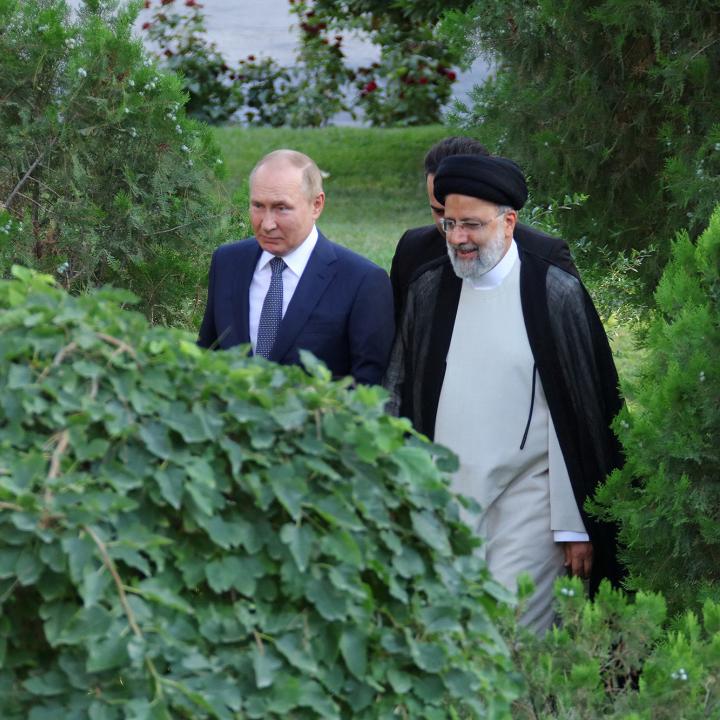

Assessing the real benefits—and limits—of joining the so-called “anti-NATO” can help policymakers better understand what Tehran, China, Russia, and other participants are getting out of their summits.
One year after the Shanghai Cooperation Organization approved Iran’s application for accession, the country is expected to take another step in the process by signing a Memorandum of Obligations at the September 15-16 SCO summit in Samarkand. Doing so would begin a year-long formal process for Iran to attain full member status.
Since its formation in 2001, the SCO has admitted new members only once before, when India and Pakistan’s applications were approved at the 2015 summit. The two countries went on to sign memoranda of obligations at the 2016 summit and be admitted as full members at the 2017 summit.
The standard memorandum that Iran will sign outlines the various obligations a country is expected to fulfill, including accession to SCO agreements and treaties such as the organization’s founding charter and its Convention on Combating Terrorism, Extremism, and Separatism. Once it has met these prerequisites, Tehran will submit the instruments of accession to the SCO Secretariat in Beijing for approval. Although such requirements may seem stiff on paper, the fact is that the SCO’s institutional capacity for ensuring these agreements are actually fulfilled is limited to two permanent bodies—the Secretariat in Beijing and the Regional Anti-Terrorist Structure in Tashkent, neither of which has the legal capacity to enforce decisions. In any case, the precedent of India and Pakistan’s accession indicates that Iran will likely become a full member in summer 2023.
The SCO is often portrayed as an inherently anti-Western bloc, with some even calling it the “anti-NATO.” In practice, however, differences between member states have constrained the bloc’s policy coordination and regional integration since its inception. This is partly due to its insufficient bureaucratic capacity and its institutional design—the SCO is governed by consensus, which limits substantive cooperation. Hence, the organization functions more as a forum for discussion and engagement than a formal regional alliance akin to NATO or the European Union.
The Samarkand summit is unlikely to deviate from this track record. Member states remain divided over the biggest global security issue of the day—Russia’s war in Ukraine—so the meeting can be expected to produce little beyond the typical SCO rhetoric on terrorism, extremism, and the emergence of a multipolar international system. Even so, the SCO will presumably use Iran’s accession to feed its discourse about the organization’s growing global posture.
For their part, Iranian officials note that the accession process has already strengthened their country’s economic situation, despite the fact that the SCO lacks any formal mechanism to boost trade among members. In July, Customs Administration spokesman Ruhollah Latifi stated that Iran’s non-oil exports to SCO countries increased 20 percent in the second quarter of 2022, totaling $5.5 billion during that period. Tehran has also hosted several events dedicated to the commercial benefits of SCO membership. Given the ongoing impasse with the West over nuclear talks and sanctions, Iranian officials have invoked involvement in the SCO as a means of legitimizing the government’s “Look East” policy.
This evolving interest in the SCO has often been portrayed as an outgrowth of Iran’s ties with Russia and China—most recently, the Ukraine war has deepened Tehran’s relationship with Moscow, while relations with Beijing have retained a prominent role under President Ebrahim Raisi. Yet the government also sees the SCO as a platform for expanding ties with lesser powers. Last year’s initial membership approval was followed by a series of Iranian diplomatic exchanges with Tajikistan, Kazakhstan, and Uzbekistan in spring and summer 2022. Indeed, the SCO gives Tehran a diplomatic forum for pursuing closer ties to the region, a process previously hampered by policy incoherence and domestic constraints. For their part, Central Asian governments see Iran as a potential transit hub and an alternative to dependence on Russia.
To be sure, Iran’s participation in the Samarkand summit and budding accession to the SCO do not represent an institutional solution to the country’s international isolation. Yet both developments nevertheless bear watching as indicators of Tehran’s growing involvement and cooperation with countries that fall within the SCO’s sphere of influence.
Nicole Grajewski is the Stanton Nuclear Security Postdoctoral Fellow at the Belfer Center for Science and International Affairs. This article is published under the auspices of The Washington Institute’s Diane and Guilford Glazer Foundation Program on Great Power Competition and the Middle East.


